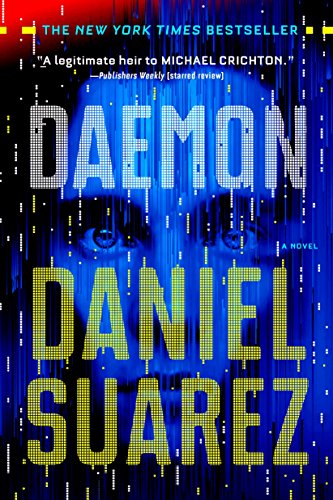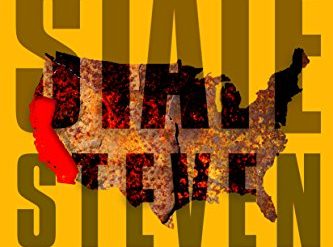
Estimated reading time: 6 minutes
Don’t be misled by the book’s title. The “daemon” of Daniel Suarez’s novel isn’t an evil spirit. That evil-sounding word is a term of art in computer science and not at all diabolical. Wikipedia defines it as “a computer program that runs as a background process, rather than being under the direct control of an interactive user.” The billions of lines of code in the software we use every day call up dozens of daemons on our laptops or cell phones. But the daemon of this novel is something else. It runs in the background on computer systems all over the world. It’s “not a thinking, talking, sentient machine. This is narrow AI. It’s a collection of specific rules searching for recognizable patterns or events. Very basic.” But you won’t want to be in the way when it starts taking over.
A manifesto for a new civilization
Daemon runs to more than 600 pages of action-packed story interspersed with ruminations on history, technology, and philosophy. It’s enough different from other novels in its genre that the technologist who introduces the Kindle edition of the book makes note of it. “While it is billed as a techno-thriller, I believe that Daemon is better understood as a manifesto . . . for a new civilization.” Which helps explain why this novel has become a cult classic among a certain set of Silicon Valley technorati.
There is nothing simple in this novel, not the technology, not the plot, not the characters, and certainly not the philosophy underlying the story. I’ve been working with computers since 1978 and am hardly a technology illiterate. Still, the technical jargon Daniel Suarez throws around so freely in this novel flew far over my head—although the context made the meaning clear enough. And I understand what’s meant by narrow AI. Then, too, the historical references resonated deeply, since I’m far more familiar with history than I am with technology. But Daemon is, above all, a terrific story.
Daemon (Daemon #1 of 2) by Daniel Suarez (2006) 632 pages ★★★★★

A fascinating cast of characters
Named characters abound in Daemon. But eight stand out clearly as pivotal.
- Matthew Sobol, the founder of the online game company Cyberstorm Entertainment. He is a certified genius, with an IQ tested at 220 and a net worth estimated at three hundred million dollars. And he dies at the age of 34 after a prolonged battle with brain cancer as the novel opens. Sobol has created the daemon that bedevils the world in his stead.
- Detective Sergeant Peter Sebeck of Thousand Oaks, California, where Cyberstorm and Matthew Sobol’s estate are located. He is the lead in the investigation into Sobol’s death and subsequent events at his estate.
- Jon Ross, a brilliant hacker and computer security consultant with a mysterious past. He is the first to understand what links the puzzling events at Cyberstorm.
- Dr. Natalie Phillips, a senior computer scientist at the National Security Agency. She is African American and is almost always the smartest person in the room. Dr. Phillips heads the inter-agency Daemon Task Force.
- FBI Special Agent Roy “Tripwire” Merritt, who leads the Bureau’s Hostage Rescue Team.
- Brian Bragg, a criminal who has grown rich by stealing the identities of high-net-worth individuals and selling them overseas to crime syndicates. He plays the massively multi-player online games (MMOGs) created by Cyberstorm.
- Charles Mosely, a convicted drug-trafficker doing time in a privately-owned prison in Texas. He is unusually bright and works successfully as a telemarketer in the prison.
- The Major, a former special operator who holds a senior position in the Department of Defense and is otherwise unidentified
Events quickly spiral out of control
Daemon opens with Matthew Sobol’s death. But almost simultaneously three others die mysteriously as well. Two are senior programmers at Cyberstorm who worked closely with Sobol, and the third works at Cyberstorm, too. Sergeant Sebeck of the local police soon finds the scene overrun with feds who have little interest in indulging his suspicions that all these deaths are linked. Because misleading evidence leads them astray, the FBI soon latches onto Jon Ross as a suspect in Sobol’s death. And they disregard his claim that somehow Sobol killed the others even though he’s dead—through narrow AI—because they can’t begin to understand it. Even worse, they ignore his warning not to invade Sobol’s estate for clues. And when they do so, the bodies start piling up. There will be more bodies. Lots more in the course of fourteen months, as this propulsive story wends its complex way toward a surprising end.
About the author

Daniel Suarez is the author of seven novels to date, all billed as techno-thrillers. Daemon was the first of them. He worked for many years as an information technology consultant to Fortune 1000 companies and possesses extensive knowledge of the technologies that play such prominent roles in his writing. He has designed and developed mission-critical software for the defense, finance, and entertainment industries. However, he is self-taught in software development and holds only a BA in English Literature from the University of Delaware. Suarez is American and was born in 1964.
For related reading
This is one of The 21 best books of 2023 and of The 7 best techno-thrillers.
I’ve also reviewed four other novels by Daniel Suarez:
- Kill Decision – Killer drones menace the USA in this military technothriller
- Delta-V (Delta-V #1) – A brilliant hard science fiction novel about asteroid mining
- Critical Mass (Delta-V #2) – This is humanity’s future in space
- Influx – Down becomes up in this clever hard science thriller
You’ll find the author among Ten new science fiction authors worth reading now.
For more good reading, check out:
- These novels won both Hugo and Nebula Awards
- The ultimate guide to the all-time best science fiction novels
- 10 top science fiction novels
- The top 10 dystopian novels
And you can always find my most popular reviews, and the most recent ones, on the Home Page.


























